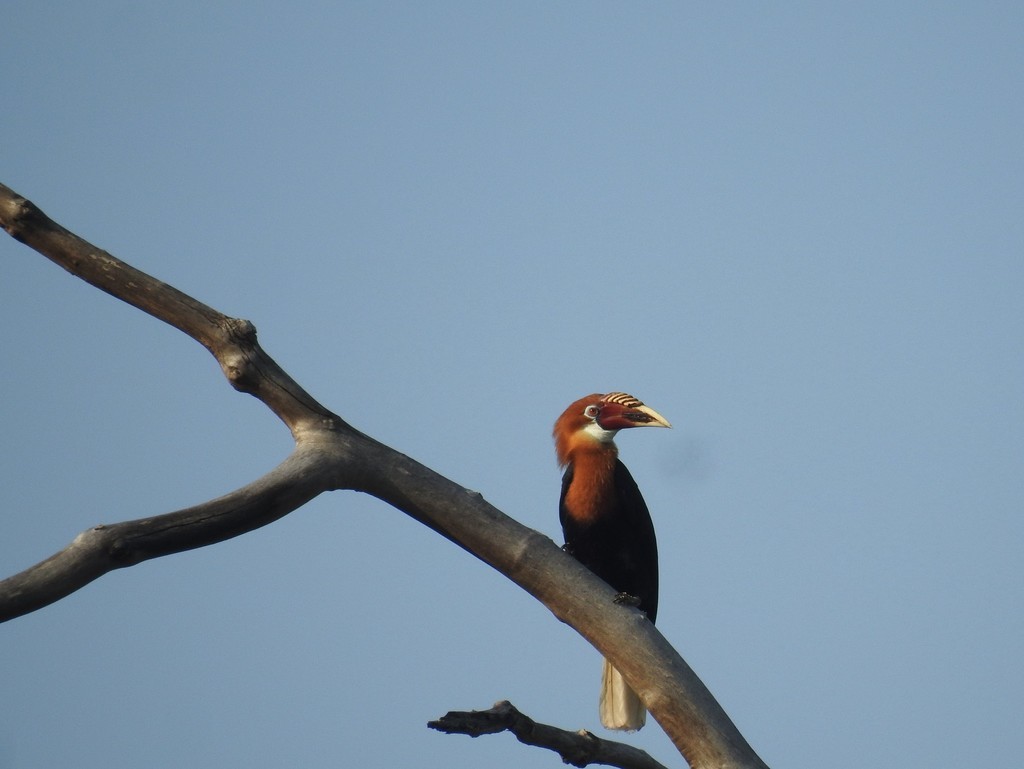Narcondam Hornbill
A species of Hornbill Scientific name : Rhyticeros narcondami Genus : Hornbill
Narcondam Hornbill, A species of Hornbill
Botanical name: Rhyticeros narcondami
Genus: Hornbill
Content
Description General Info
 Photo By abhishektimothygopal , used under CC-BY-NC-4.0 /Cropped and compressed from original
Photo By abhishektimothygopal , used under CC-BY-NC-4.0 /Cropped and compressed from original Description
The Narcondam hornbill is a small hornbill at 66 cm (26 in) long. The sexes differ in plumage. The male has a rufous head and neck, black body and upper parts glossed with green. Females are all black. There is a bluish white throat patch and the tail is white in both sexes. Both sexes have a bill with a few folds on the upper side towards the base of the upper mandible. The skin around the eye is bluish. The iris of the male is orange red while the female has an olive brown with a pale yellow ring. The bill is waxy and the furrows of the casque are brownish. The bill is pinkish towards the base. The legs are black and the sole is yellow. 
Size
50 cm
Nest Placement
Tree
Feeding Habits
Narcondam Hornbill primarily feeds on a variety of fruits such as figs, alongside seeds from various trees. They also consume invertebrates and small reptiles, occasionally mobbing predators like sea eagles. Their frugivory aids in seed dispersal, crucial to forest ecology.
Habitat
The habitat of narcondam Hornbill includes littoral forests with hibiscus and pandanus, deciduous regions with gyrocarpus, and primarily evergreen forests dotted with planchonella and syzygium. This environment, noted for one of the highest global fig densities, supports a thriving narcondam Hornbill population. Additionally, narcondam Hornbill resides in mossy, epiphyte-rich cloud forests on its native island.
Dite type
Frugivorous
General Info
Feeding Habits
Bird food type

Fruit
Distribution Area
The bird is a resident of fairly open mixed forest that stretches over most of the island from sea level to about 700m. However most Narcondam Hornbill nests are found below 200m. For nesting and roosting, the bird prefers mature undisturbed forest with large trees. The favored nesting trees are Sideroxylon and Sterculia species. The entire population (estimate of about 200 birds in 1905 and 1984) is restricted to the single island of Narcondam in the Andaman Island chain. The island is clothed in forests and rises to a height of about 2300 feet above sea level. It is largely devoid of human presence. The island is often hit by cyclonic storms in the Bay of Bengal. In 2000, an estimate of 434 birds was made for the population, with a density of 54 to 72 birds per square kilometre on the island, which has an area of about 6.8 square kilometres. A nest site density of 2.8 pairs per square kilometer has been estimated. 
Species Status
Some human presence on the island has been noted recently and Since 2009 the Narcondam hornbill has had a Conservation status of Vulnerable. The island of Narcondam has in the past been largely unpopulated. Goats were introduced several times on the island in the past, and a visit in 1991 revealed that feral goats had proliferated around an old police outpost. In 2011 there was a proposal by the Indian Coast Guard to erect a radar station and a diesel power generation station for it on the island. This was opposed due to the threats of increased human activity and disturbance and the threat to a number of endemic island species, including the hornbill. The plan was finally cancelled by the Ministry of Environment and Forests in 2012. However, in the wake of the Chinese monitoring activity in Myanmar's neighbouring Coco Island, the nod for the listening station was granted in June 2014. 